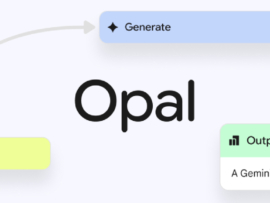
Google has launched Opal, an experimental tool designed to make building AI-powered applications as easy as typing an idea. The tool enables users to build and share “mini apps” by simply describing what they want in plain English.
“Opal introduces a new way to create with AI,” said Google’s product team in the official announcement. “It’s about empowering creators, innovators, and doers to build the tools they imagine by transforming simple prompts into powerful mini apps.”
Opal is part of a growing trend in what’s being called “vibe-coding” — a term popularized by OpenAI’s Andrej Karpathy — referring to the emerging class of tools that allow users to build software through natural language, rather than code.
How Opal works
Opal offers a visual workflow editor that transforms a user’s prompt into a functioning app. Each step in the process, from input to output and generation, is mapped visually, making it easy to understand and modify. Users can tweak prompts, add features, or insert tools through a side panel.
Users can either begin from a blank canvas or explore a gallery of prebuilt demo apps. These templates can be modified and extended, allowing users to easily customize and remix existing functionality. Once a user finishes building, the app can be shared instantly via a link. Others can access it using their own Google accounts.
“Just describe the logic, and Opal builds the visual workflow for you,” Google wrote in their announcement.
Positioning Opal in the no-code and AI creation landscape
While Google already offers tools like Jules to assist developers, Opal is aimed at a broader audience — individuals with ideas but no programming background. This approach aligns Google with other major players, such as Cursor, Lovable, Canva, Figma, and Replit, all of which offer AI-assisted creation tools that eliminate the need for manual coding.
The rise of no-code AI platforms is drawing significant attention from investors and users alike, reflecting increased confidence in these tools’ potential to democratise app development.
Last week, Lovable, an eight-month-old Swedish AI startup focused on no-code app creation, became a unicorn after closing a $200 million Series A round led by Accel, valuing the company at $1.8 billion.
Another standout is Cursor, developed by a lean team at Anysphere. The company hit $100 million in annual recurring revenue (ARR) in January 2025, and that number had doubled by March.
With Opal, Google is signalling a long-term bet on natural language interfaces as the future of software development. Since Opal is still in experimental beta, Google plans to refine it based on user feedback. For now, it’s limited to the US, but a wider rollout could happen if the tool gains traction.
While Opal isn’t yet suited for full-scale commercial apps, it opens doors for faster prototyping and internal tool-building, suggesting that the future of app development may not require coding at all.
Missed the Google I/O 2025 keynote? No worries — we unpacked Sundar Pichai’s biggest AI moves and what they mean for the future of Android and beyond.





